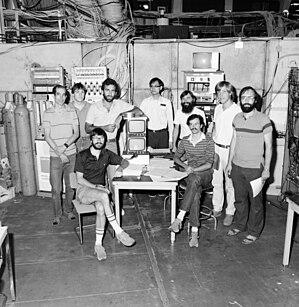
The TRAP experiment, also known as PS196, operated at the Proton Synchrotron facility of the Low Energy Antiproton Ring (LEAR) at CERN, Geneva, from 1985 to 1996. Its main goal was to compare the mass of an antiproton and a proton by trapping these particles in the penning traps. The TRAP collaboration also measured and compared the charge-to-mass ratios of antiproton and proton. Although the data-taking period ended in 1996, the analysis of datasets continued until 2006.
Experimental setup
| Low Energy Antiproton Ring (1982–1996) | |
|---|---|
| Antiproton Accumulator | Antiproton production |
| Antiproton Collector | Decelerated and stored antiprotons |
| Antimatter Factory (2000–present) | |
| Antiproton Decelerator (AD) | Decelerates antiprotons |
| Extra Low Energy Antiproton ring (ELENA) | Decelerates antiprotons received from AD |
In the first step, the antiprotons obtained from the LEAR entered the TRAP apparatus. They were immediately slowed down using the degrader foils. The first penning trap was used to the accumulate the entering antiprotons. While the second trap, located very close to the first one was used for the precision measurements. The number of antiprotons entering the degrader foils were counted using a scintillating device. A number of antiprotons coming out from the degrader foils were observed using an attached detector. The apparatus was cooled down to the liquid helium temperature for these measurements.
The penning traps used strong magnetic fields to contain charged particles. The issue with storing antiprotons was that they required very stringent vacuum conditions, otherwise they would easily interact with the gas atoms in the medium and annihilate quickly. The TRAP collaboration achieved vacuum pressure as low as , with less than 1 annihilation per day. The special type of trap-geometry and use of superconducting solenoid that would cancel the magnetic fluctuations were the crucial design aspects of the TRAP setup.
Results
The ratio of inertial masses of antiproton () and proton (p) was calculated to be 0.999,999,977 0.000000042. This result had a fractional uncertainty of , which was 1000 thousand times more accurate than the previous measurements, that evidently implied the existence of CPT symmetry for the baryons. This result was obtained by comparing the cyclotron frequencies of the protons and the antiprotons.
The ratio of antiproton to electron inertial mass was determined to be 1836.152660 0.000083, while the proton to electron inertial mass ratio was found to be 1836.152680 0.000088.
The lower limit on the decay lifetime of the antiprotons was established to be 3.4 months.
See also
References
- ^ Philippe Bloch (2012). "LEAR's physics legacy". CERN Bulletin.
- "In the steps of the antiproton". CERN Courier. 2015-08-26. Retrieved 2021-07-07.
- "Greybook". greybook.cern.ch. Retrieved 2021-07-07.
- ^ Gabrielse, G.; Kalinowsky, H.; Kells, W.; Trainor, T. A. (1985). "Proposal to the PSCC: precision comparison of antiproton and proton masses in a penning trap". Cern Document Server. CERN. Geneva. Proton Synchrotron and Synchrocyclotron Committee.
- ^ Gabrielse, G.; Fei, X.; Orozco, L.; Tjoelker, R.; Haas, J.; Kalinowsky, H.; Trainor, T.; Kells, W. (September 1990). "Thousandfold improvement in the measured antiproton mass". Physical Review Letters. 65 (11): 1317–1320. Bibcode:1990PhRvL..65.1317G. doi:10.1103/PhysRevLett.65.1317. ISSN 0031-9007. PMID 10042233.
- Gabrielse, G.; Fei, X.; Orozco, L. A.; Tjoelker, R. L. (1989). Electron cooling of trapped antiprotons and a new measurement of the $\overline{P}$ inertial mass: a progress report to the PSCC by the TRAP Collaboration (PS196). CERN. Geneva. Proton Synchrotron and Synchrocyclotron Committee.
- Precision Comparison of $\bar{p}$ and $ p $ Masses in a Penning Trap. 2002.
- Gabrielse, G.; Fei, X.; Helmerson, K.; Rolston, S. L.; Tjoelker, R.; Trainor, T. A.; Kalinowsky, H.; Haas, J.; Kells, W. (1986-11-17). "First Capture of Antiprotons in a Penning Trap: A Kiloelectronvolt Source". Physical Review Letters. 57 (20): 2504–2507. Bibcode:1986PhRvL..57.2504G. doi:10.1103/PhysRevLett.57.2504. PMID 10033784.
 , with less than 1 annihilation per day. The special type of trap-geometry and use of superconducting solenoid that would cancel the magnetic fluctuations were the crucial design aspects of the TRAP setup.
, with less than 1 annihilation per day. The special type of trap-geometry and use of superconducting solenoid that would cancel the magnetic fluctuations were the crucial design aspects of the TRAP setup.
 ) and proton (p) was calculated to be 0.999,999,977
) and proton (p) was calculated to be 0.999,999,977  0.000000042. This result had a fractional uncertainty of
0.000000042. This result had a fractional uncertainty of 

 , which was 1000 thousand times more accurate than the previous measurements, that evidently implied the existence of
, which was 1000 thousand times more accurate than the previous measurements, that evidently implied the existence of